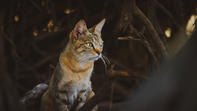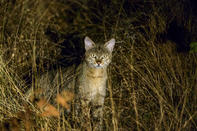The African Wild Cat (Felis silvestris lybica) is an indigenous species of Africa and an ancestor of the domestic cat. They look like domestic cats, but have longer legs enabling them to sit almost vertically upright.

Wild cats have a sandy to reddish brown coat, with darker variations primarily found in wetter areas and lighter variations in drier regions, and faint to bold stripes, almost like a tabby cat, but with fewer stripes and stripes being more widely spaced.
They often have cream patches on their throats, abdomen and between their forelegs. An adult wild cat will be 85 to 100 cm long and weigh 2,5 to 6 kg. Their track is similar to that of a caracal, only smaller. The length of an adult’s right front and back foot is around 36 mm long. They are quite solitary animals, except during the mating season or when a female is tending to kittens.
Females produce up to five kittens per litter, which start to hunt when they are about 12 weeks old and become independent by five months of age. They are listed as a vulnerable species, because they are subject to hybridisation with domestic cats. Pure strains are completely wiped out in some settlements where there are domestic cats.
Killing and Feeding Pattern

Wild cats primarily eat small animals, such as rodents, hares, birds, reptiles, amphibians and spiders, but are considered a major predator of chicken and small lambs that are up to four days old in some places.
They only take one lamb at a time, with the lamb usually being bitten around the throat, dragged away and sometimes covered up. There will be clear claw marks under the skin.
Sometimes the lamb is not killed, resulting in a swollen neck, drooping head and the lamb making gurgling sounds from a tracheal puncture. Wild cats normally eat the chest meat and inner thighs of their preys, but leave the intestines.
Management
Wild cats rarely cause major problems to livestock. Damages can be prevented through the use of jackal-proof fencing (a mesh fence that is about 1,2 m high with openings of 74 mm), electric fencing, kraaling of vulnerable animals, noise, light or sound deterrents, the use of guard animals, such as Anatolian dogs, donkeys or ostriches and shepherds to look after the sheep during times of vulnerability.
Farmers need a permit to capture a wild cat. The use of cage traps with bait, normally used for caracal, work well when trying to capture these cats.
By Glenneis Kriel